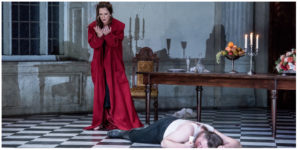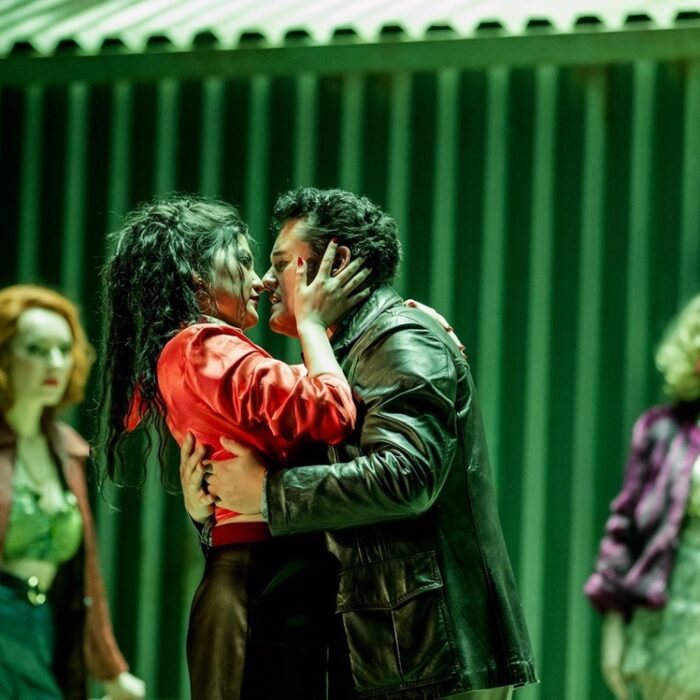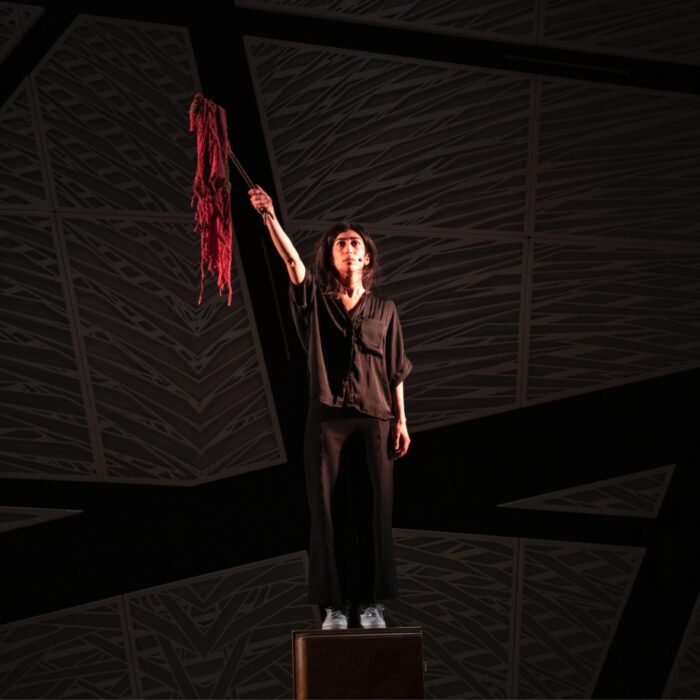
English National Opera 2022-23 Review: Tosca
Sinéad Campbell-Wallace Shines in Christof Loy’s Insightful Production
By Benjamin PoorePhoto: © Genevieve Girling
Christof Loy’s new production of “Tosca” for English National Opera, which first appeared in Helsinki in 2018, replaces Catherine Malfitano’s show, which received two revivals during its tenure and last appeared on the Coliseum stage in 2016. The production sees Leo Hussain return to the Coliseum pit – a distinguished Music Director of Opéra de Rouen and Salzburg Landestheater – with Richard Farnes, former music director of Opera North, stepping in for two performances at the end of the run in November.
Loy’s production of this piece represents a something of aesthetic and intellectual break with both Maltifano’s show and Jonathan Kent’s production down the road at the Royal Opera House Covent Garden, both of which bend towards naturalism and relative faithfulness to Luigi Illica and Giuseppe Giacosa’s text and Puccini’s relatively circumscribed dramatic vision.
Paranoia Abounds
Loy retains the core performing traditions of the piece – candles are placed by the murdered Scarpia; Tosca removes the crucifix from the wall (though doesn’t place it on the body) – but introduces a more dreamlike and symbolically saturated mise-en-scene in place of the expected naturalism. A richly-embroidered theatrical curtain sweeps around the Act two set – the whole thing is designed in obliquely angled rectangles that shrink and confine ever more with each act, ending in Cavaradossi’s prison cell – to remind us that theatricality is an important substance in both Tosca and Scarpia’s world. It returns to shield the lovers for their climactic Act three duet, though then it represents Tosca’s delusions about what is going to happen when the soldiers open fire; playacting isn’t a match for bullets, at the end of the day. The very final scene, which opens with a freeze-frame, is hauntingly nightmarish. Indeed, how could this end any other way?
Loy manages to successfully bolt-on the degree of spectacle expected by audiences of this core repertory piece without compromising too far the graphic austerity of his minimalist style, thanks to clean designs from Christian Schmidt and bright, airy lighting from Olaf Winter (again, a break from the norm in this piece, which sees most designer opting for a gloomy chiaroscuro that is either evocative or soporific, depending on what you’ve had for dinner before curtain up.) Scarpia’s entry with his goons from upstage happens with remarkable panache, and the scene climaxes with the garish spectacle of Scarpia lavishly kissing a rotund Cardinal’s ring, who looks a little like Champaigne’s famous portrait of Richelieu. The choreography of Tosca’s climactic leap from the battlements, timed to coincide with the blackout, is impeccably done.
One of Loy’s interventions is to give Cavaradossi an apprentice (uncredited in the programme), who sees the events of Act one unfold – Angelotti’s flight, Tosca and Cavaradossi’s squabbling – until he is bundled away by Spoletta and his heavies never to be seen again. In an opera with so much eavesdropping and surveillance it establishes the tension early on – who can be trusted, what have they heard, and what will they say under torture?
Costumes too are well-deployed, and make a refreshing break from the overcooked opulence that normally attends the piece. Tosca enters Scarpia’s offices after her cantata in an extravagant black dress, that, as the latter turns the screws on both her and Cavaradossi, she sheds piecemeal until reduced to a simple black slip that catches her at her most vulnerable. (It also makes her final dive at the climax of the opera considerably more elegant than the hitched-up-skirt shuffle that one usually gets.) The multi-period approach sees the forces of reaction in eighteenth-century periwigs and the free-thinker Voltarian Cavaradossi in modern dress.
The very excesses of the work – what draws people to return to the famous remark about it being a “shabby little shocker” – belong to the feverish extremes of the imagination and the inner turmoil of the characters. Scarpia writhes around on the floor at the climax of Act one in a frenzy of sexual anticipation, as the assembled congregation and clergy look on bemused.
There are some missteps: why the shepherd boy – buoyantly sung by Matilda McDonald – appears to Cavaradossi in his cell as Tosca seems a rather heavy-handed way of articulating the desperation and longing that attend a condemned man. Likewise, Scarpia fondling Tosca during ‘Vissi d’arte’ makes the scene too busy and undercuts a vulnerability and anguish expressed in the music and otherwise carefully built up by Loy’s production over the course of the scene.
Psychological Detail
Sinéad Campbell-Wallace took the title role. As an actor she brings much psychological detail and makes Tosca thrillingly, unstably capriciou – a singer who has spent so much time being looked at onstage – and looked at by Scarpia – that her insecurities loom large indeed. There is a fragility and naivete that is touchingly rendered in this performances, full of well-judged gestures.
Vocally she brings umber-hued warmth to the middle and lower registers, seductive and wounded by turns. There was emotional shading in spades, cheeky and playful at one moment and fiery with jealousy and rage the next. Top notes, particularly in a crystalline “Vissi d’arte,” were unfailingly secure.
Adam Smith sang Cavaradossi with unerring control and plenty of power. It is a gleaming voice that does not struggle to fill the cavernous Coliseum, and has enough energy and spin to be able to drop suddenly to pianissimo without losing tone or intimacy with the audience. He may have slightly overexerted himself in Act two, as some of the final duet’s high notes wanted for a little of the earlier polish – but there’s no denying the sheer thrill in the auditorium when he sustained a barnstorming “Vittoria!” for what seemed like an eternity. He is a vibrant stage presence and brings an easy charm to the role, without swaggering.
Noel Bouley walked the role of Scarpia owing to illness, while last-minute replacement Roland Wood sang compellingly from the side of the stage, which ended up being surprisingly well-coordinated. Lucia Lucas played it straight as the Sacristan – no farcical bumbling – and managed to generate a feeling of nervy terror as Scarpia and his thugs closed in. Msimelelo Mbali made a haunting impression in his brief spot as Angelotti. John Findon’s oily Spoletta is another highlight.
Hussain conducted hell-for-leather, moving the drama along probably a little faster than perhaps some of his singers would like – no indulgences granted for divas to bask in their applause that night – but kept the dramatic string pulled tight. This was especially effective in the electrifying climaxes of Act two, especially when all three principals came together, and the orchestra let rip. Loy has brought a production of imagination and light-footedness to ENO, which deserves to see several effective revivals.
The performance was prefaced by a poem from spoken word artist Kieron Rennie that offered a pithy synthesis of the opera’s stakes – much more engaging, probably, than most of the synopses one reads in programmes.


